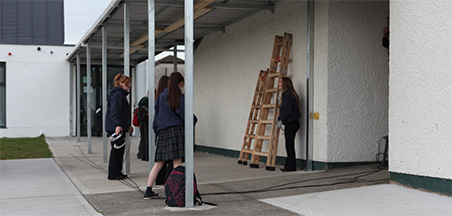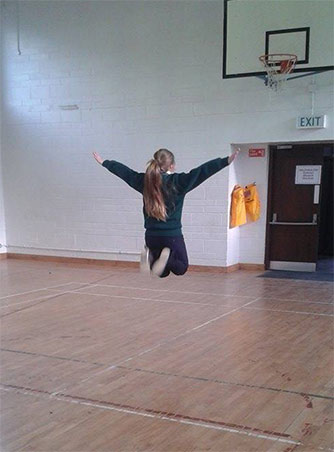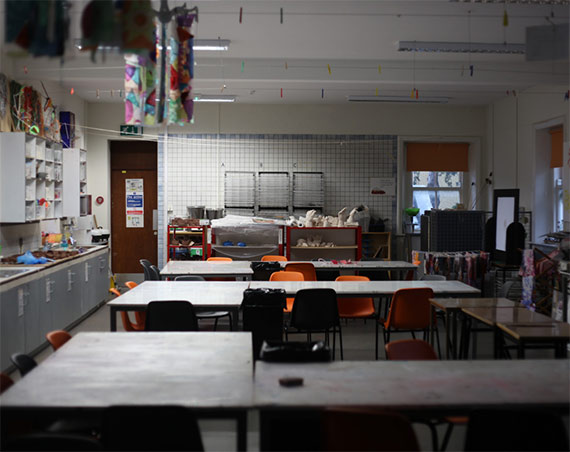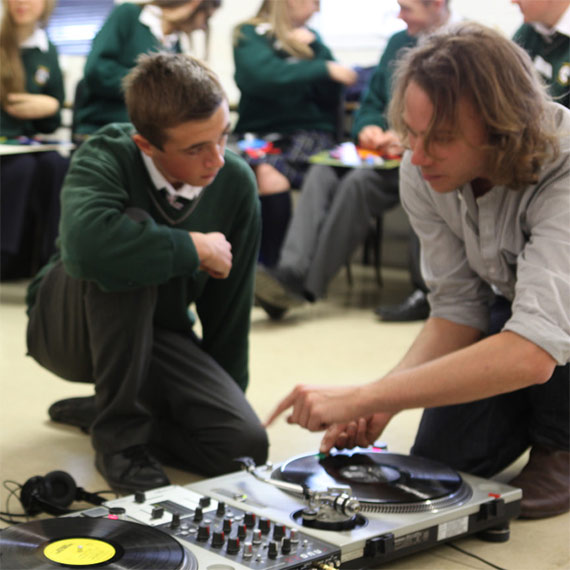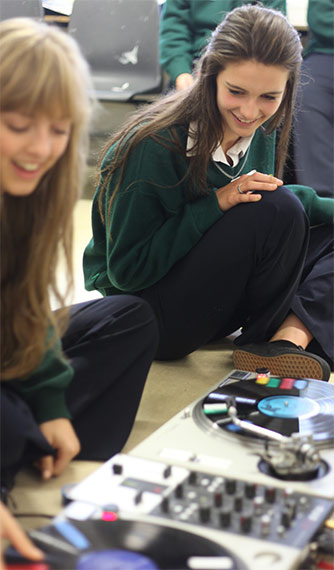Refine by Region
Refine by Art Form
Refine by School Level
Thinking Visual
(c) Jennie Guy
Briefly tell us the story of your project – What was it about? Who was involved? How did it get started?
Jennie:
In early 2014 I received the Thinking Visual Residency Award, run by Wicklow County Council & Mermaid Arts Centre. I proposed a new type of residency within Blessington Community College, where artists John Beattie, Sven Anderson and myself as project curator would work with transition year students to explore activities that lay between producing new artwork and developing a conceptual framework within which to present it. This residency provided a unique experience for both the students and the school to focus on this process-driven phase of contemporary art production, and highlight vital links between the artist as researcher and students as inventive learners. John Beattie gave a focus to moving image work and Sven Anderson evolved sonic frames of reference with the students.
Sven:
The curator Jennie Guy invited me to take part in a six-week residency programme working with transition year students in Blessington Community College in County Wicklow, in late 2014. Between October – December, I met with the students, Jennie Guy, and the art teacher Turlough Odonnell once a week.
Much of my practice is focused on contemporary sound art practices, so I initiated the project with an energetic workshop based on physically manipulating vinyl LPs. Using blades, electrical tape, and sandpaper, the students made physical marks on the surfaces of records that I sourced in a bargain bin in a charity shop in Dublin. Most of the students had never been near a record before .. and immediately we found ourselves having conversations about media manipulation, the sense of hearing, noise and silence, and what distinguishes noise from music from art.
I spent the next sessions presenting a variety of material to the students – some of it interactive, some of it more based on creating the time and space to listen to and comment on significant artworks in this field. These conversations crossed many boundaries by addressing subjects and techniques that were outside of what many of the students would consider as art. Each week provided the chance for another listening session – and we listened to works by Max Neuhaus, Bill Fontana, John Cage, Alvin Lucier, Christina Kubisch, Sam Auinger, and Luc Ferrari (amongst others).
After one particular conversation about sound installations in public places, the students began to express a strong interest in making a sound installation for their school. We quickly focused on conducting site surveys of the schools grounds (looking for the right site to work into), developing a concept for the work’s structure and content, and going over all of the practical aspects of making such an installation. We invited the school’s principal to the next workshop and the students themselves made a presentation proposing the installation, and asking for permission to construct it.
On the final day of the residency, I spent the entire day at the school working on the installation.
The final sound installation (installed by the students with help from their teachers from art, woodworking, metalworking, and the school’s maintenance staff) is formed by four boards spanning over 40 ft, mounted overhead in the outdoor passageway. The boards are fitted with sound transducers, transforming the boards into resonating speakers. The students choose combinations of sounds from an online database of field recordings uploaded by various sound artists that drift between boards throughout the day (played back from a computer / hardware setup installed in one of the classrooms), providing a backdrop to the everyday sounds taking place outside their school. This piece is still installed outside of the school in early 2015.
Turlough:
Between September and December 2014 Jennie Guy (Art School / Mobile Art School) curated an artist residency in Blessington Community College. The residency consisted of six workshops for the Transition Year students. There are two classes in Transition Year in Blessington, one class worked with artist Sven Anderson and the other class worked with artist John Beattie. Over the six weeks students were introduced to the work of their resident artist, experimental workshops were carried out where students explored the processes involved in Sven and John’s work. From these explorations proposals for works in video and sound were developed. These proposals were then presented to the School Management and ultimately art works were produced with the artists working closely with the students at all times.
What aspects of the project made you smile? What aspects of the project made you feel challenged?
Jennie:
As each subsequent week of the residency went by I looked forward to each residency session as I knew that there would a lot of unexpected laughs generated by each artist’s session. John Beattie really pushed the boundaries of the students perceptions of experimental moving image works. He gave the groups he worked with such freedom that they were able to devise and follow through with their ideas from session to session. Seeing the students achieve such experimental works was really exhilarating for me as an observer and really fun for the students. At times I felt quite challenged at the end of each session in trying to describe what had happened from the artists and students perspective. I knew the ideas and research that the artist was trying to evolve but somehow trying to make it relevant to this student audience I would begin to stutter in my round-up. Turlough O’Donnell the art teacher has a really unique talent of being able to process the ideas the artist was bringing to his classroom and school but somehow contextualise it as a teacher and then re-present each session with great articulation to his students that I felt that I was learning a lot from him.
John:
During my third session with the students, I set a self motivated brief for the day, to give the students an opportunity to experiment with ideas independently using the camera & lens, throughout the grounds of the school. The students explored ideas and methods discussed and demonstrated from previous sessions. At the end of the task, students gathered in the art room, and I projected all images the students had shot large scale for all to view and critique. To my delight, a group of students had created a sequence of images, illustrating one of their peers “flying” steadily, in the air, through the school building. Using a Stop-Motion camera technique, the students discovered an imaginative approach, which later became the central focus of the projects final video. A fantastic moment.
Working with large groups of mixed teenagers can be very challenging to ensure that each individual feels apart of the process. Also, monitoring how engaged students are, and if students are engaging at all. It’s crucial for me that I create that space for students to feel comfortable and confident to come forward and be involved in the creative process. This was the most challenging yet rewarding aspect of the project.
Sven:
There were so many moments working on this project that made me smile. One of the funniest moments occurred when we were talking about the artist / composer John Cage, in particular his composition 4 minutes 33 seconds. This piece is a performance in which the audience (and performer) remains silent for this exact duration of time, highlighting the ambient sounds of the performance space and demonstrating that there really is no such thing as silence – and that many incidental sounds can become ‘material’ when given appropriate focus. We were in the middle of uploading our own version of this piece via a new 4’33” iPhone App – sitting in a circle, listening to the sound of nothing – of our breath, of the creak of chairs, the subtle passing of cars outside. This duration can feel like a long time for a group of teenagers – sitting still, trying not to laugh, trying to stay quiet. One of the students was holding a ‘virtual baby’ / ‘infant simulator’ – one of these fake baby dolls that the students have to take care of, tending to their needs. Suddenly – in the middle of our silence – the baby let out a computerized cry. The laughter that had been hiding behind the silence suddenly broke and we were all laughing, the sound being uploaded to the app to be stored with hundreds of other ‘silences’ recorded around the world.
There were many moments like this – in which our focus on listening, and on the medium of sound, forced us to negotiate with many aspects of space and experience that we would never have had to confront if we were working in a more visual medium. By the end of the residency, I felt that we had a strong group dynamic, and a good understanding of how we could work together as a group both to understand more difficult concepts, and to work towards producing a significant impact on our environment – as evidenced through the successful installation of the sound installation outside of the school.
Turlough:
Seeing the student’s reaction to appearing in the video work really made me smile, particularly because the young girl who became the focus for the main video piece is a very quite student, and she got a real kick out of making the piece. Also the first video piece involved another student being given the power to move chairs with his mind this also was very funny to see his performance in front of the students.
In the sound work shop seeing all the students engage with the artist made me smile. I and the students really enjoyed the field recording trip to Dublin also. On this trip we recorded the everyday sounds of the city; these sounds were later incorporated into a piece of sculpture the students had made in response to Sven’s sound workshop. The whole project / residency challenged the students notions of what is and what is not art and they now have a broader appreciation of what is involved in contemporary art practise.
What insights from the project are worth sharing?
Has anything changed as a result of the project?
Jennie:
I must acknowledge the strength and benefit of forming strong background relationships that substantiate residencies like this. For example, without the backing, support and most importantly the creative vision of Wicklow Country Arts Office and Mermaid Arts Centre this project would never happen. My approach to creating firm and supportive relationships has deepened even more, this does take more time but now that I can see how exciting ongoing connection with schools can emerge from this type of relationship gives everybody involved in this type of project a great sense of achievement. The same approach goes for really involving the artist as early as possible before a project, either in conversation and or doing site visits and being able to communicate as much as possible before a project starts. This project has given a lot of confidence to approach new contexts.
John: I heard from the schools art teacher that after one of our sessions, a usually quite student came up to him and said that the session and work done was; “poetry in motion”.
Another aspect worth sharing from the project, is the careful and considered level of detail carried out by curator Jennie Guy, with the school and art teacher Turlough, to co-ordinate and manage this process. The atmosphere and fundamental creative environment, had been set in place and in motion, making this an extremely smooth and successful project.
I think there is a large number of things that have changed as a result of the project, some measurable, many others not so easy to measure: For the school, Principal, art teachers, and most importantly the students, to experience a sense of what is possible, what can be done, of how to step outside of the school curriculum and produce innovative and challenging work. I feel people’s perspective and perceptions changed in relation to art within the secondary level education system. This also goes for myself as an artist and educator, that we can bring dynamic, relevant, and engaging art practices into the school education system, and produce work and working relationships, where the integrity of project is completed with the highest level of engagement.
Sven:
The project’s structure – established by the curator Jennie Guy – was quite a substantial framework to begin with. I have had experiences with workshops in which the artist is completely responsible for establishing frames of reference with the teaching staff, the school, and the students. In this case, the curatorial framework that Guy established with Turlough ODonnell (the art teacher) set the ground for more adventurous work within the residency – in which I was free to develop my own ideas in response to the students’ interests as they emerged / developed over the course of the residency. The resulting environment (within these sessions) allowed us to move very quickly and to cover quite a bit of ground in six weeks, and the support and exchange with the students, the art teacher, and the curator all felt substantial and easy to balance.
I sense that the impact of having the sound installation – quite a substantial experiential structure – built outside of the school in Blessington marked a significant change in all of our expectations concerning how far we might go with this kind of experimental learning framework. This was not an expected outcome of the project – and beyond the process of producing what I consider to be a considered artwork, our experience working together and learning to ask for a chance to shape or author our environment – in this case the environment of the school – was quite significant. I believe that enabling the students to make a legible mark on their surroundings is a valuable experience in breaking down the borders between self / space (environment) / and authority, resulting in a more active approach to establishing democratic spaces.
Turlough:
The approaches of both artists have given the students great insight into the working practices of contemporary artists. Sven’s work in the field of sound sculpture has the potential to create a greater awareness in students to their surrounding particularly to the sound environment of the school. As a teacher the engagement with both artists has had a very positive effect on my own approach to teaching. I believe that it is very important as a teacher to open the subject up and by getting professional artists into the art room with the students has an energising effect.
I think that students will be more open minded as a result of the project. Some students have even started to explore new media on their own. One group of students created their own video piece in and entered it in a competition called “Youth Connect”. Their work was short listed to 12 which were screened in the Savoy cinema last week. I have no doubt that the video residency with John would have influenced and informed their approach.
Students’ report
Our names are Shona O’Connor and Aoife Mescall, we were students involved in the residency who worked with Sven in the area of sound sculpture.
On the day we were introduced to Jennie and Sven, Sven told us about his area of work and told us what he wanted us, as a class, to learn from the residency. To introduce us to the basics of sound, he brought us in old records with very different genres and sounds and played them on his record player, which he also taught us how to use throughout the day. As an experimental activity, we each chose a record at random and used tape, sand paper and knives to mark and scratch the record to make different sounds and interruptions on the track when it played.
Following up on working with records, Sven gave us the task of making some sort of sculpture using the record covers. The class decided to build a ‘sound tower’ by taping the covers together in various different ways and installing small speakers to the sculpture.
After a couple of weeks, along with Sven, the class came up with the idea of making putting up a semi-permanent sound installation somewhere in the school to make others aware of the sounds around them. We came up with the concept of attaching four small speakers to four long planks of wood that would go up on the ceiling of the shelter outside the first year corridor.
In preparation for proposing our idea to Mr Burke, our principal, we had to plan to tell him what we wanted to do, how we were going to do it and what we wanted to get out of this project. We chose two pupils to help Sven to pitch the idea to Mr Burke and from the very start he was on board with helping us complete the task. Different people were given different jobs that they had to complete as their part-taking in the completion of the project. Some were in charge of preparing the wood for the speakers to be securely installed and others helped in choosing the sounds we were going to play.
At first no-one could really hear the sounds we were trying to make noticeable, so Sven and Mr O’Donnell worked on fixing it and making it louder.
On the last week in the residency, Sven came in and helped us put everything together. Outside Sven helped other pupils feed wires and cables through the wall to ensure we would be able to connect the speakers to electricity, while the rest of the students helped Donal, our care taker, secure the planks to the ceiling of the shelter to be ready to be connected. Other students stayed inside to make a final decision on the sound they were going to play and what went well together. Everything was just about finished when the final bell of the day rang. To thank Sven and Jennie for all their hard work and time they had spent with us, we presented them with a bottle of wine as a small token of our appreciation.
When people were beginning to become aware of the sounds being played, confusion was their initial reaction. They were curious as to where it was coming from, as they were not aware we had been working on this project. However when they got used to it, they listened closely and carefully to the sounds and tried to figure out the type of sound that was being played.
We feel our class really enjoyed the experience and learned a lot about how art is not just in pictures and paintings. We all got along really well with Sven and found it a very interesting and new experience. We were also thought about how interesting it is to stop and listen to how versatile the sounds in a particular environment can be.
Overall we think the project was a massive success and really enjoyed working in such a different area of art.
Spotlight
Artist(s):
John Beattie
Beattie’s work explores ideas and perceptions relating to notions on the Artist, the studio, and relationship with the audience. Through process-based and context-specific methodologies, his work employs the use of video, drawing, and performative intervention. Concerned with methods of production and representation, his curiosity lays with how the viewer/audience engages with or unravels the creative process. Born in 1980, John Beattie is originally from Co.Donegal and currently lives and works in Dublin. He has been artist in residence at Fire Station Artists' Studio, Dublin, 2006-2009; Royal Hibernian Academy, Dublin, 2010; Temple Bar Gallery & Studios, Dublin, 2011; and The Irish Museum of Modern Art, Dublin 2011. He has exhibited nationally and internationally with recent selected exhibitions including: Hennessy Portrait Prize, The National Gallery of Ireland, Dublin, 2014; A Line of Inquiry, Fort Dunree, solo show, Co.Donegal, 2014; An Artist, The Studio, and all the rest, solo show, The Royal Hibernian Academy, curated by Patrick Murphy, Dublin, 2012; Long Drawn Out, Catalyst Arts Gallery, Belfast, 2013; The Artist Studio Series, The Process Room, The Irish Museum of Modern Art, Dublin, 2011; The Artist Studio Series (If The Art...), The Return Gallery, Goethe Institute, Dublin, 2010; Fragile, Le Carre Bonnat, Musee Bonnat, curated by Francois Loustau, France, 2009; Awards include: Arts Council Projects Award, 2012; Arts Council Visual Artist Bursary, 2006, 2007, 2010; Donegal County Council Artist Bursary, 2005, 2006, 2013; Open EV+A Award, Limerick City Gallery of Art, 2005; Arts Humanities Research Board, 2003-2005. In March, 2015, John Beattie will be an apexart fellow, New York. apexart's New York City Fellowship program is focused on cultural exchange and new experiences, providing an intense, explorative journey into New York. The awarded Fellowship was nominated by Gavin Murphy, Pallas Projects Director, Dublin.
Sven Anderson
Sven Anderson is an artist working between Ireland and the US since 2001. Anderson's work explores the act of listening within diverse architectural, physical, social, and emotional contexts. His practice is a discursive platform that operates through artistic intervention, academic publication, participatory processes, and interactive design. His public art project MAP: Manual for Acoustic Planning and Urban Sound Design was awarded the European Soundscape Award by the European Environmental Agency (EEA) in 2014.
Anderson's installations and performances are parasitical, feeding off of details of the immediate built environment, the bodies of the audience, and fragments of local history and ecology to suggest emergent, site-specific forms.
Teacher(s):
Turlough O’Donnell, Teacher
Turlough O’Donnell is a graduate of Fine Art from the National College of Art and Design, Dublin. He lives and works in Blessington, County Wicklow. He has been working as an Art teacher in Blessington Community College since 1994. During this time he has also maintained his own art practise. Working primarily in the medium of oil paint, he uses his immediate environment that which is close at hand is his starting point; the town where he lives; the surrounding mountains; the rivers and lakes.
Other:
(Curator, agency, etc):
Jennie Guy, Curator
Jennie Guy is an artist, researcher, and independent curator based in Dublin. She is the co-founder and director of Mobile Art School, a project that aims to disseminate contemporary art practices within a primary and secondary school context, 2011-2014. She is interested in expanding the relationships between students, schools, artists, curators, and exhibition venues, and is currently evolving a strategic methodology that highlights the potential of creative and evaluative documentation. Recent projects include: Thinking Visual, an artist residency in Blessington Community College (Co. Wicklow); The Artist Stays, a 30-week artist residency in St. Catherines NS (Co. Dublin); The Thinking Hand, a workshop series in Whitecross NS (Co. Meath); and a series of workshops for the Summer Rising Festival at IMMA in 2014. Within this mode of practice she has worked with many artists exploring different media including: Sven Anderson, John Beattie, Stephen Brandes, Michelle Browne, Karl Burke, Rhona Byrne, Felicity Clear, Hannah Fitz, Jane Fogarty, Mark Garry, Russell Hart, Emma Haugh, Vera Klute, Vanessa Donoso Lopez, Ruth Lyons, Isabel Nolan, and Tamarin Norwood. Recently Jennie has been involved in a research residency in RUA RED, and developing a new series of arts in education projects between Dublin, Wicklow, Roscommon, and Monaghan.
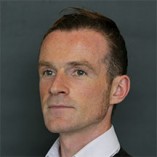
Artist(s)
John Beattie
Sven Anderson
Jennie Guy

Teacher(s)
Turlough O’Donnell
Artforms
School Level
School/
Participant Group
Blessington Community College
No. Participants
60
Region
Age/Class
Transition Year
Dates
September - December 2014
Weblinks
Leading Agency
Wicklow Arts Office
Other Partners and/or Funders
Art School ??, Mermaid Arts Centre
Curriculum Strands
Art, Science, Maths, Physics, SPHE, English
Research or relevant publications
I believe it is very important as a teacher to open the subject up and by getting professional artists into the art room with the students has an energising effect.
Turlough O'Donnell, Teacher
